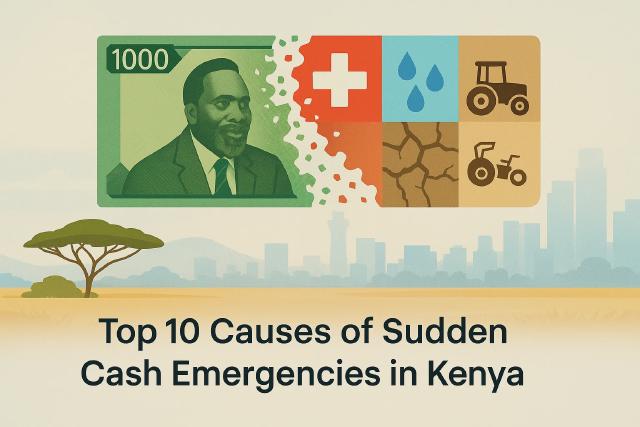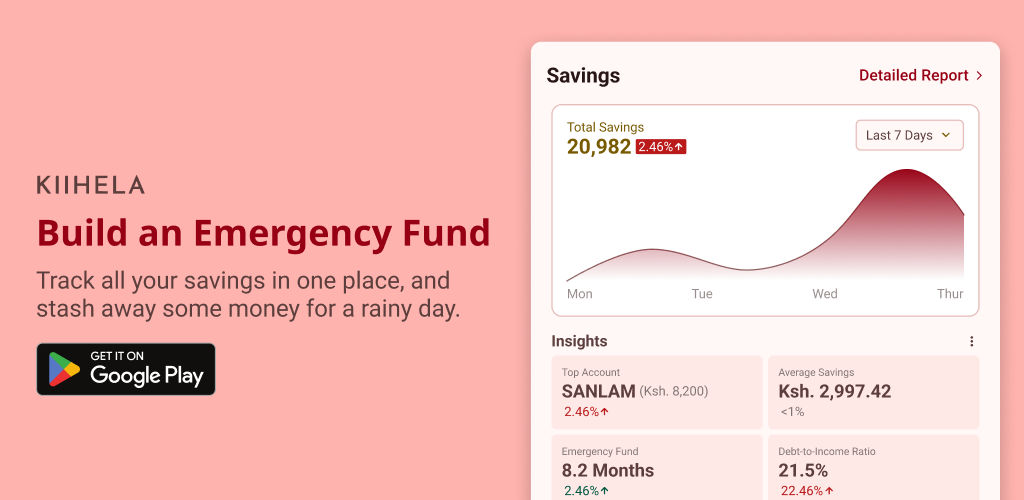Introduction
In Kenya, sudden cash emergencies are all-too-common. Unexpected events can drain savings, disrupt livelihoods, and often pushing families into debt. Understanding the most common causes of these emergencies is essential for building financial resilience and preparing for the unexpected.
The FinAccess Household Survey is conducted by the Central Bank of Kenya (CBK), Kenya National Bureau of Statistics ( KNBS), and Financial Sector Deepening Kenya (FSD) annually. It provides valuable insights into various aspects of the financial lives of Kenyans, including their access to financial services, usage patterns, and the challenges they face.
The 2024 FinAccess Household Survey was released in May 2025 and reveals crucial insight into the financial challenges that Kenyans face the most. This article explores the top 10 causes of sudden cash emergencies in Kenya, based on the survey’s findings, attempts to explain why they occur, their impact, and the scale of the problem. By shedding light on these issues, we aim to empower individuals and policymakers to take proactive steps toward financial stability.
1. Major Health Issues
Health emergencies top the list as the leading cause of sudden cash emergencies in Kenya. When illness or injury strikes, the financial burden can be overwhelming, especially in a country where access to affordable healthcare remains limited. With low insurance penetration—only about 15% of Kenyans have health insurance—the majority of households bear the full cost of medical care out of pocket.
According to the 2024 FinAccess Household Survey, 33.7% of Kenyan households reported experiencing a major health issue that triggered financial strain. This burden is felt more acutely in rural areas (34.9%) than urban ones ( 31.7%), where medical facilities are scarce, and transportation costs to hospitals add to the expense. Common health crises include malaria, which affects millions annually, and chronic conditions like diabetes and hypertension, requiring ongoing treatment. For example, a severe malaria case might cost between KSh 10,000 and KSh 50,000, while managing diabetes could demand KSh 2,000 to KSh 5,000 monthly. Without savings, families often turn to loans, sell assets like livestock, or delay treatment—leading to worse health outcomes and even higher costs later.
2. Loss or Damage Due to Drought
Kenya’s reliance on agriculture makes drought a devastating trigger for sudden cash emergencies. Failed rains lead to crop losses and livestock deaths, hitting farmers and pastoralists hard and causing ripple effects across the economy. As food prices soar, even urban households feel the pinch.
The 2024 FinAccess Household Survey found that 13.7% of households faced financial shocks from drought-related losses. Surprisingly, urban areas reported a higher incidence (15.9%) than rural ones (12.2%), likely due to increased food costs and supply chain disruptions.
For a farmer in arid regions like Turkana or Kitui, losing a season’s maize crop or a herd of goats can erase months of income. With recurring droughts—exacerbated by climate change—recovery becomes nearly impossible before the next dry spell hits. This leaves families scrambling for cash to cover basic needs like food and school fees.
3. High Rainfall or Flooding
On the flip side, excessive rainfall and flooding also rank among the top causes of financial emergencies in Kenya. Floods destroy homes, wash away crops, and damage infrastructure, leaving households with immediate and long-term costs.
The survey reports that 11.9% of Kenyan households experienced financial shocks due to flooding, with rural areas ( 13.4%) more affected than urban ones (9.6%). Regions like the Rift Valley and Western Kenya are particularly prone to these disasters.
The 2024 floods, for instance, displaced thousands and caused millions in damages. A family might lose their mud-walled home or an entire harvest, requiring urgent funds for relocation, repairs, or even medical care if waterborne diseases spread. With little access to emergency aid, these costs often fall squarely on the household.
4. Death of the Main Income Earner
The sudden loss of a household’s primary breadwinner is a profound shock, both emotionally and financially. Beyond the grief, families face immediate funeral expenses and the daunting challenge of replacing lost income. Per the 2024 FinAccess Household Survey, 10.0% of households cited this as a major financial emergency, with equal impact in rural and urban areas. In Kenya, where social safety nets are minimal, funeral costs can range from KSh 50,000 to over KSh 100,000, depending on cultural traditions.
For a widow in Nairobi’s informal settlements or a rural farmer’s family, this loss can mean selling land or taking on debt just to cover burial costs. Long-term, the absence of income threatens children’s education and basic survival, locking families into poverty.
5. Job Loss or Wage Cuts
Economic instability, whether from local business closures or global downturns, can lead to sudden job losses or wage reductions—another major driver of cash emergencies. Urban households, reliant on formal employment, are hit hardest. The survey indicates that 15.9% of urban households faced job loss or wage cuts, compared to just 5.9% in rural areas. In Kenya’s informal sector, where over 80% of workers operate without contracts or benefits, income is already unstable.
A matatu driver laid off due to rising fuel costs or a factory worker facing reduced hours might see their income vanish overnight. With no unemployment insurance and high living costs in cities like Nairobi, families quickly exhaust savings, turning to high-interest loans or informal lenders to survive.
6. Business Closure or Failure
Small businesses are the backbone of Kenya’s economy, but they’re also vulnerable to failure, making this a significant cause of sudden cash emergencies. Economic shifts, competition, or unexpected expenses can force closures, leaving owners in financial distress.
While the survey doesn’t provide a specific percentage, business failure is a notable concern, particularly in urban centers where entrepreneurship thrives. A kiosk owner in Mombasa, for example, might shut down due to rent hikes or declining sales, losing both income and invested capital.
The ripple effect extends beyond the owner—employees lose wages, and debts pile up. Without a financial cushion, these entrepreneurs face an urgent need for cash to cover personal expenses, often resorting to borrowing or asset sales.
7. Theft or Burglary
Theft and burglary strike unpredictably, stripping households of valuable assets or cash and creating immediate financial gaps. From livestock rustling in rural areas to break-ins in urban slums, crime is a persistent threat. The 2024 FinAccess Household Survey identifies theft as a key financial shock, though exact figures aren’t specified. In pastoralist regions like Samburu, losing a herd to raiders can wipe out a family’s wealth, while urban thefts—such as stolen phones or savings—demand quick replacement funds.
Victims often lack insurance or police recovery options, forcing them to dip into savings or borrow. The emotional toll can also reduce productivity, compounding the financial strain.
8. Legal Disputes or Fines
Legal troubles, though less common, can still trigger sudden cash emergencies. Court fees, fines, or settlements can drain finances unexpectedly, especially for those without legal support.
The survey notes this as a financial shock, particularly for small business owners or individuals caught in disputes. A trader fined KSh 20,000 for violating county regulations or a farmer facing a land dispute might need to pay legal fees ranging from KSh 10,000 to KSh 100,000.
Without resources to fight or settle these cases, households face a stark choice: pay up or risk greater losses, such as jail time or property forfeiture. This unpredictability makes legal issues a hidden but potent financial risk.
9. Unexpected Education Costs
Education is a priority for Kenyan families, but sudden expenses—like fee hikes or emergency school needs—can strain budgets. The 2024 FinAccess Household Survey reveals that 18.3% of households struggle to pay school fees, up from 16.9% in 2021.
A parent might face a surprise demand for KSh 5,000 in exam fees or KSh 10,000 for a child’s uniform after a growth spurt. In rural areas, where incomes are lower, these costs can force families to borrow from saccos or pull children from school, jeopardizing their future.
With education costs rising and public funding limited, these unexpected expenses remain a significant source of financial pressure across Kenya.
10. Vehicle or Equipment Breakdowns
For Kenyans who depend on vehicles or machinery—think matatu drivers or farmers with tractors—breakdowns can lead to sudden repair costs and lost income. This cause, while not detailed in the survey, is a common reality.
Repairing a motorcycle might cost KSh 5,000 to KSh 20,000, while a tractor fix could exceed KSh 50,000. In a country where spare parts are expensive and mechanics scarce in rural areas, these breakdowns hit hard.
A boda boda rider sidelined for a week loses daily earnings, while repair bills pile up. This dual financial blow—lost income and high costs—makes equipment failures a critical emergency trigger.
Conclusion
Sudden cash emergencies in Kenya stem from a mix of health crises, climate shocks, economic instability, and unforeseen events. The top 10 causes outlined here—drawn from the 2024 FinAccess Household Survey—paint a picture of a nation grappling with vulnerability, yet striving for resilience.
These financial shocks disproportionately affect the poor, who lack savings or insurance to cushion the blow. Addressing them requires a multi-pronged approach: expanding healthcare access, strengthening climate adaptation, and improving financial inclusion. For households, understanding these risks is the first step toward preparation—whether through emergency funds or community support.
As Kenya moves forward, tackling these causes head-on will be key to ensuring fewer families face the chaos of sudden cash emergencies.
References
2024 FinAccess Household Survey Report


